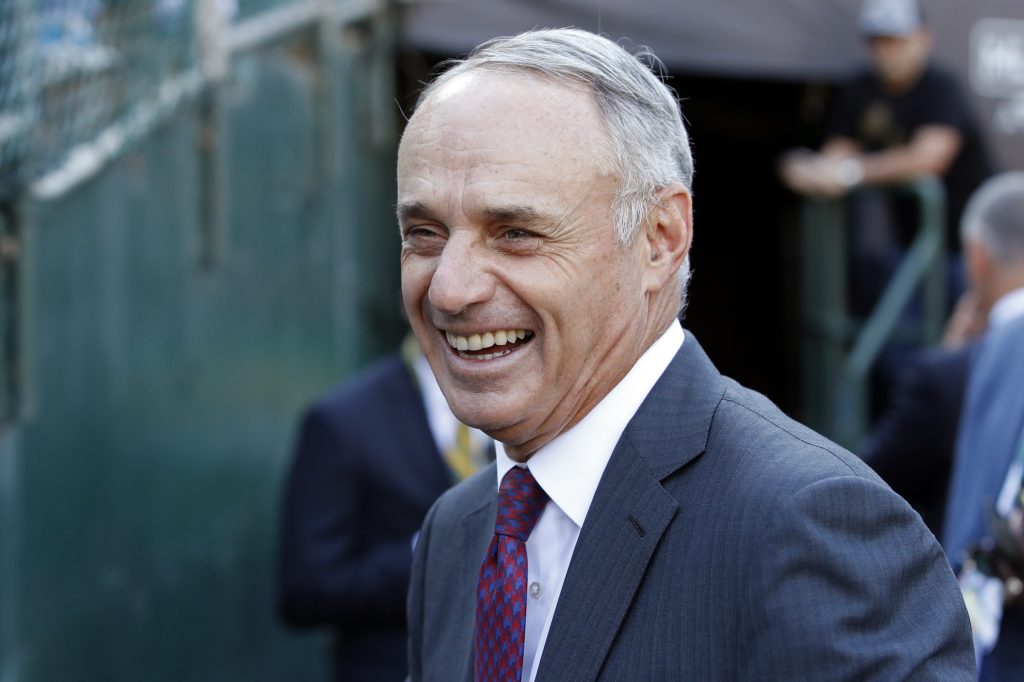
MLB’s self-imposed deadline to reach an agreement with the Players Association is today, and Evan Drellich, Ken Rosenthal and Fabian Ardaya of The Athletic report that the league took a “more threatening” tone to the MLBPA today and voiced a willingness to miss a month’s worth of regular-season games (Twitter link). The first meeting between the two parties today lasted only 40 to 45 minutes, tweets Michael Silverman of the Boston Globe, though the expectation is that negotiations will continue throughout the day.
The players have, unsurprisingly, taken that as a clear threat, tweets ESPN’s Jeff Passan, although there’s been no indication to this point that the union’s solidarity has begun to wane. The players have generally taken an exceptionally united front, even in the wake of what was seen as a discouraging counterproposal from the league late last week. There’s been little expectation that the league and union would be able to avoid the “disastrous outcome” of canceled regular season games (as described by commissioner Rob Manfred himself), so the only notable component of that threat is the number of games the league is willing to miss.
The Associated Press estimates that each day of canceled games would result in a collective $20.5MM of missed salary for the players, although it’s worth emphasizing that the union has envisioned just such a hardline tactic from the league for years and has been stockpiling funds to weather this type of storm. MLBTR’s Tim Dierkes reported over the weekend that the league’s strike find is “exponentially” larger than it has ever been (Twitter thread). The MLBPA has been holding back full licensing revenues for years to safeguard against this type of scenario, and the players also spun their licensing department into a separate company, MLB Players Inc.
In doing so, the players afforded themselves the ability to take equity in other companies. Jared Diamond of the Wall Street Journal profiled MLB Players Inc.’s deal with Fanatics over the summer, and they’ve also taken an equity stake in OneTeam Partners. The result is a considerable increase in the union’s funds, and while an exact dollar amount isn’t known, there are a couple pieces of information that can provide relevant benchmarks. An Associated Press report earlier this month indicates the union had as much as $178.5MM at year-end in 2020. An LM-2 Form filed to the U.S. Department of Labor suggests the number was $171.4MM for the 2020 calendar year. Either figure is dated by now, and the size of the fund only figures to have grown.
Notably, players can apply for monthly stipends in the absence of collecting their salaries. The union had provided a pair of $5,000 stipends for February and March, and Drellich and Rosenthal report that the figure will jump to $15,000 beginning on April 1 (when the regular season would be underway). Not all players will apply for that stipend, of course, but in theory even if they did, the 1200 stipends would cost the union a total of $18MM. Add in a pair of (again, theoretical) $6MM payouts for February and March, and it still only taps into $30MM of the union’s funds. Realistically, even based on the 2020 numbers and not accounting for 2021 licensing revenues, the union likely has more than enough capital to make it through the whole season paying out those stipends.
While it’s true that the sport’s biggest stars won’t bat an eye at a $15,000 monthly stipend and may not even file to collect it, that figure is crucial for the union members on the lower rung of the pay scale. Consider players who were just added to 40-man rosters over the winter and those who’ve not yet solidified themselves as big league regulars. Those players could well be looking at spending much of the season in Triple-A, and the $15,000 stipend would largely account for that minor league salary — in some cases, with Double-A and Class-A players who’ve been added to the 40-man roster over the winter, the stipends may even exceed their would-be minor league salaries.
The prospect of lost salaries doesn’t sit well with the union, but the game’s star players who are on lengthy multi-year contracts can surely weather the loss, and those who are most vulnerable are generally taken care of via the monthly stipends. There’s an undeniable middle class who’d be getting squeezed — pre-arbitration players who are solidified on the MLB roster — but those players are among the ones the union is fighting for most ardently, insisting upon increases in minimum salary and pushing for earlier paths into arbitration. Broadly speaking, there’s good reason to believe that even amid the loss of salaries, MLBPA solidarity is likely to remain strong.
Credit : Source link






